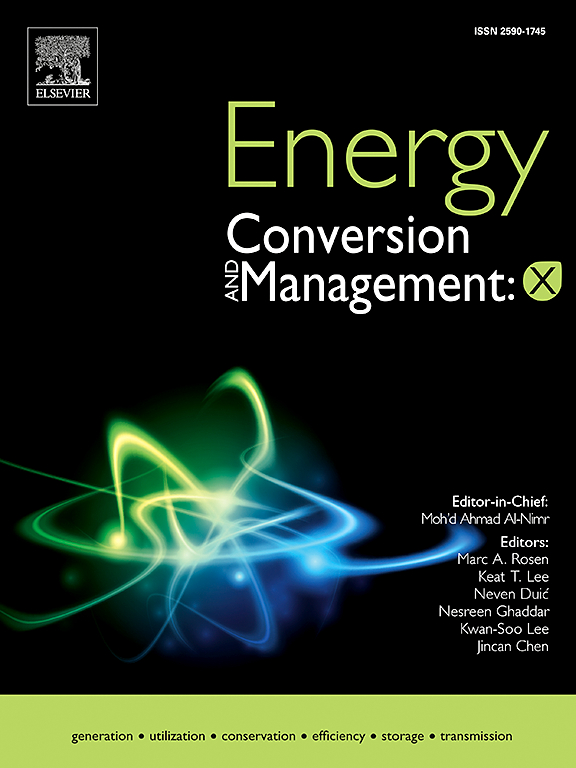Proton exchange membrane fuel cells: advances in materials development, performance optimization, and future outlook
IF 7.6
Q1 ENERGY & FUELS
引用次数: 0
Abstract
Proton exchange membrane fuel cells (PEMFCs) are emerging as a promising energy conversion technology for sustainable power generation, offering high efficiency, low emissions, and adaptability to various applications, including transportation, stationary power systems, and portable electronics. This review critically examines the recent advancements in PEMFC components, including proton exchange membranes, catalyst layers, gas diffusion layers, and bipolar plates, focusing on material innovations, performance enhancements, and durability improvements. The study highlights recent developments in membrane technologies, such as perfluorosulfonic acid membranes, alternative hydrocarbon-based polymers, and composite structures, aimed at enhancing proton conductivity, mechanical stability, and hydration management under varying operational conditions. Furthermore, advancements in catalyst materials, including platinum group metal alloys, non-precious metal catalysts, and atomically dispersed catalysts, are discussed concerning their electrochemical activity, cost-effectiveness, and stability under fuel cell operating conditions. The impact of gas diffusion layer architecture, microporous layer optimization, and novel flow field designs on mass transport characteristics and water management is critically discussed. Additionally, this study examines key challenges, including high production costs, inadequate infrastructure, and technical barriers related to water management, membrane durability, and catalyst efficiency. Recent modeling and simulation approaches for optimizing fuel cell performance, including multi-physics simulations and machine-learning-assisted diagnostics, are also examined. Finally, future research directions are outlined, emphasizing the need for innovative materials, scalable manufacturing techniques, and integrated hydrogen economy strategies to accelerate the global deployment of PEMFC technology to meet net-zero emissions targets by 2050.

质子交换膜燃料电池:材料发展进展、性能优化及未来展望
质子交换膜燃料电池(pemfc)是一种新兴的能源转换技术,具有高效、低排放、适应各种应用的特点,包括运输、固定电力系统和便携式电子设备。本文回顾了PEMFC组件的最新进展,包括质子交换膜、催化剂层、气体扩散层和双极板,重点介绍了材料创新、性能增强和耐用性改进。该研究强调了膜技术的最新发展,如全氟磺酸膜、替代烃基聚合物和复合结构,旨在提高质子导电性、机械稳定性和在不同操作条件下的水化管理。此外,还讨论了催化剂材料的进展,包括铂族金属合金、非贵金属催化剂和原子分散催化剂,讨论了它们在燃料电池工作条件下的电化学活性、成本效益和稳定性。讨论了气体扩散层结构、微孔层优化和新型流场设计对质量输运特性和水管理的影响。此外,本研究还探讨了关键挑战,包括生产成本高、基础设施不足、水管理、膜耐久性和催化剂效率相关的技术障碍。本文还研究了用于优化燃料电池性能的最新建模和仿真方法,包括多物理场仿真和机器学习辅助诊断。最后,概述了未来的研究方向,强调需要创新材料、可扩展的制造技术和综合氢经济战略,以加速PEMFC技术的全球部署,到2050年实现净零排放目标。
本文章由计算机程序翻译,如有差异,请以英文原文为准。
求助全文
约1分钟内获得全文
求助全文
来源期刊

Energy Conversion and Management-X
Multiple-
CiteScore
8.80
自引率
3.20%
发文量
180
审稿时长
58 days
期刊介绍:
Energy Conversion and Management: X is the open access extension of the reputable journal Energy Conversion and Management, serving as a platform for interdisciplinary research on a wide array of critical energy subjects. The journal is dedicated to publishing original contributions and in-depth technical review articles that present groundbreaking research on topics spanning energy generation, utilization, conversion, storage, transmission, conservation, management, and sustainability.
The scope of Energy Conversion and Management: X encompasses various forms of energy, including mechanical, thermal, nuclear, chemical, electromagnetic, magnetic, and electric energy. It addresses all known energy resources, highlighting both conventional sources like fossil fuels and nuclear power, as well as renewable resources such as solar, biomass, hydro, wind, geothermal, and ocean energy.
 求助内容:
求助内容: 应助结果提醒方式:
应助结果提醒方式:


